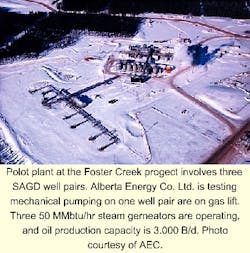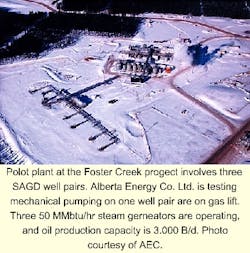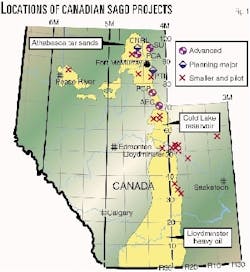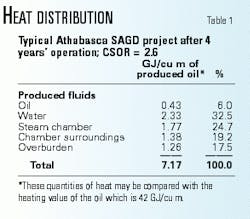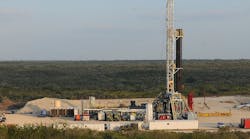Steam-assisted gravity drainage (SAGD) is being used increasingly for the recovery of bitumen and heavy oil in Canada.
Four large SAGD projects are under construction in Athabasca, and two others have been announced. These projects are expected to produce bitumen economically and with a recovery greater than 50%. Productivity will be close to 1,000 b/d/well pair.
There are also many successful smaller, and growing, projects and pilots in Athabasca, Cold Lake, and Lloydminster.
Because of the rising costs of fuel, it is desirable to reduce steam requirements for SAGD. Means for doing this include cogeneration of steam and power, alternate fuels, choosing better reservoirs, improved heat recovery, and the newer related processes, steam and gas push (SAGP) and vapor extraction (Vapex).
In SAGD,1-3 SAGP,4 and Vapex,5 the oil is reduced in viscosity and produced by gravity drainage to horizontal wells placed low in the reservoir. As the oil drains, the vacated reservoir pores are filled largely with gas-steam in SAGD, steam plus noncondensible gas in SAGP, and solvent vapor plus noncondensible gas in Vapex.
A common feature of the three processes is that the use of long horizontal wells combined with the reduced viscosity of the produced oil allows the production of oil with essentially no bypass of free gas.
In suitable reservoirs, economic rates are achieved, whereas with conventional wells or without adequate viscosity reduction there would be intolerable gas coning. High recoveries are obtained because of the systematic nature of the drainage.
Since the author's earlier work in this series,6 there has been a great increase in the interest in this subject, and there are now many substantial field projects in various stages of planning and construction.
Athabasca projects
SAGD is at the stage where several major field projects to recover bitumen from Athabasca are either under construction or about to be.
In most cases the reservoirs are thicker than those that have been exploited previously, and superior results are anticipated.
The initial investment for large SAGD projects is of the order of $10,000 (Can.)/b/d of capacity, and the steam-oil ratio (SOR) is 1.9-2.5. The supply costs for bitumen will probably be less than $10 (Can.)/bbl including return but excluding the fuel cost. This important cost is discussed later.
Generally product lifting from the reservoir is by natural flow, a technique first demonstrated by Sceptre Resources Ltd. and now used in several of the pilots.
Four large commercial SAGD projects are described below. Fig. 1 shows the approximate locations of the projects discussed below.
- Alberta Energy Co. (AEC) Foster Creek.7 This is a commercial expansion of AEC's pilot project, which produces 2,000 b/d from three SAGD well pairs. The reservoir is of a high quality: 25 m net pay, 33% porosity, and 85% oil saturation.
An interesting feature of the project is that, although there is a bottom water zone, the injection pressure (4 MPa) is above the initial reservoir pressure (2.3 MPa); it is thought that a basal cold-bitumen seal contains the pressure and confines the steam. The initial expansion will involve 24 well pairs to produce 20,000 b/d; steam injection will start in 2001. Further expansion to 100,000 b/d is planned.
- PanCanadian Petroleum Ltd. Christina Lake.8 The first phase of this project will produce 10,000 b/d of bitumen from a lease 170 km south of Fort McMurray. Two following phases will each produce 30,000 b/d. Phase 1 will be operated for 12-18 months prior to the design of Phases 2 and 3.
The design of Phase 1 is based upon SAGD experience obtained elsewhere, particularly from the successful project at Senlac in the Lloydminster area. The initial project will be in high quality sands more than 30 m in thickness. There is no top water and only limited bottom water.
- Suncor Inc. Firebag.9 Suncor is developing its Firebag lease using SAGD. The reservoir quality is excellent with, in Phase 1, an average net pay of 37 m, horizontal permeability of 7 darcies, a bitumen saturation of 84%, and a porosity of 32%.
This will employ 20-30 well pairs to produce 35,000 b/d and is planned to be in full operation in 2004; further phases will bring the total to 140,000 b/d by 2010.
Product will be shipped by pipeline to Suncor's McMurray upgrader 48 km to the southwest. The design of the facilities employs the experience obtained by Suncor in its successful Burnt Lake three well-pair pilot in the Cold Lake area.
- Petro-Canada MacKay River.10 Petro-Canada is constructing a project to produce 30,000 b/d of bitumen from its MacKay River lease, a few kilometers east of Northstar's Dover Underground Test Facility (UTF).
The reservoir is similar to that at the UTF, and Petro-Canada is utilizing the experience and data obtained as a participant in the UTF project. During the 25-year life of the project a total of 120 well pairs will be drilled from 24 pad locations.
Developing SAGD projects
Two further large SAGD projects have been announced and are in the planning stage.
- Canadian Natural Resources Ltd. Mic Mac. CNRL is developing plans for an SAGD project to produce 100,000 b/d at this site 85 km north of Fort McMurray. This SAGD project will supplement a 200,000 b/d oil sands mine.
- OPTI Canada Long Lake. This is to be a 30,000 b/d SAGD project 40 km southeast of Fort McMurray. Construction is planned for 2002 with completion in 2004.
SAGD pilots, small projects
Here is a list of smaller commercial SAGD projects arranged from north to south.
- NorthstarEnergy Corp. Dover. This successful Athabasca project, about 18 km east of the Syncrude site and originally named the UTF project, is continuing and producing several thousand barrels per day. The successful operation of self-flowing wells drilled from the surface has been demonstrated. A Vapex pilot will be constructed shortly.
- Shell Canada Ltd. Peace River. This site has several SAGD projects. The most successful contains five well pairs drilled in 1996 producing about 250 b/d/pair with an SOR of 4.5. The reservoir is of a poorer quality: low permeability, variable oil saturation, and bottom water. High water intrusion contributes to the poor SOR.
- Japan Canada Oil Sands Ltd. Hanging stone. This SAGD pilot, in the Athabasca deposit 50 km southwest of Fort McMurray, has been operating successfully since 1999 and is expected to be the forerunner of a commercial plant. The earlier CSS pilot on this site was unsuccessful.
- Gulf Canada Resources Ltd. Surmont. Gulf has produced from a two well-pair pilot on this lease since late 1997. Results are satisfactory, and commercial development is anticipated.
The reservoir is thick and of a high quality but is overlain by water and gas. Recently gas production in the area has ceased in order to preserve the pressure in the reservoir. The top water is undesirable because it will increase the steam requirement-several groups are studying this problem of top water.
- CNRL Burnt Lake. This is a successful pilot producing about 1,600 b/d from three well pairs. It was purchased from Suncor, and expansion is expected.
- CNRL Wolf Lake. CNRL purchased this single well pair, now producing about 550 b/d, from Amoco and has added five well pairs recently.
- BlackRock Ventures Inc. Hilda Lake. A single well pair is producing 360-550 b/d in this Cold Lake field depending upon the steam pressure. Another pair is to start in 2000. A 10,000 b/d project known as Orion, which will later be expanded to 20,000 b/d, is planned.
- Murphy Oil Canada Ltd. Lindbergh. This project has two horizontal SAGD producers with six vertical injectors.
- Marathon Oil Canada Ltd. Bolney. This project has 19 horizontal producers with 39 injectors, mostly vertical.
- CNRL Tangleflags. This pioneering project, which now has 13 producing SAGD wells with multiple vertical injectors in Tangleflags North field, was acquired with Sceptre Resources. The first of these wells produced 2.5 million bbl of oil between 1988 and 1998. Two SAGD well pairs have since been built in Tangleflags East and are operating successfully.
- ExxonMobil Canada Ltd. Celtic. This is a single well pair producing 550 b/d.
- Probe Exploration Ltd. Kitscoty. This project consists of four horizontal SAGD producers with five intermediate vertical injectors.
- Husky Energy Ltd. Pikes Peak. This single well pair produces about 500 b/d.
- Marathon Oil Canada Edam Sparky. This project has one SAGD producer with two vertical injectors.
- PanCanadian Senlac East. This project has seven SAGD well pairs. The best well pair produces about 1,000 b/d. The pioneering project demonstrated deep self-flowing wells.
- Nexen Inc. Plover Lake. The company plans a single SAGD well-pair pilot.
- Gulf Canada Kerrobert. This project consists of three SAGD producers with offset horizontal and vertical injectors.
Limitations to SAGD
Three factors that have important effects upon the economics of SAGD projects are discussed below.
1. The rising cost of fuel.
A major consideration in the development and operation of SAGD projects is the cost of generating steam. Important factors that must be considered are the SOR and the cost of the fuel required per cubic meter of steam. This cost has risen quickly because of the increasing price of the main fuel, natural gas.
With heat recovery it requires about 500 scf of natural gas to produce 1 bbl of 100% quality steam (89 standard cu m/cu m). In efficient SAGD projects the SOR is 2-5, depending upon the reservoir and fluid properties, so the gas required falls in the range of 1,000-2,500 scf/bbl of produced oil.
When natural gas had a value of $1 (Canadian)/Mcf, the cost of fuel would have been $1-2.50/bbl of produced oil. However, with the recent rise in the cost of gas to $5-8/Mcf, the fuel cost for SAGD has become $5-20/bbl of oil. Since the value of the produced oil has not increased proportionately, there is an increased need to minimize fuel consumption and cost in SAGD operations. Means for achieving economy include:
- Reducing steam cost by the cogeneration of steam and electrical power.
- Using cheaper fuels such as coal or bitumen, but these involve additional environmental problems. The use of steam drawn from a nuclear power plant is conceivable.
- Improving the performance of SAGD by selecting better quality reservoirs. Desirable characteristics are: thick continuous reservoirs, high oil saturation, high permeability, and no top water. For example, it is expected that the Christina Lake project will have an SOR of 1.9.7
- Efficient recovery and reuse of the heat contained in the produced fluids.
- Adding noncondensible gas to the injected steam to reduce the heat requirement. In suitable reservoirs this can reduce the steam requirement by about one third; the corresponding reduction in supply cost, including fuel, could be $3/bbl for present gas prices. The process is known as SAGP4 and is most effective in thicker reservoirs. The gas should be added from the start of steaming.
- Using Vapex. This process has only a minor fuel requirement but consumes a solvent such as propane. There is a large economic incentive for its application to pressure-depleted heavy oil reservoirs, and several pilots are planned.
2. Light-heavy price differential.
Although for some uses, particularly for asphalt manufacture, heavy oil and bitumen are more suitable and economic than conventional light crude oils, they are less valuable for the manufacture of most petroleum products.
Their conversion to common petroleum products requires additional refinery conversion processes such as coking or hydrocracking and severe hydrotreating processes to remove sulfur, nitrogen, and in some cases for aromatics conversion. This additional processing is done in special upgrading plants, by the modification of refineries, or by combinations of the two.
As the proportion of heavy oil and bitumen in the crude supply increases the expansion of conversion facilities must occur, and the differential in price between heavy and light crudes must be large enough to justify their construction. As the supply of light crude dwindles its price will rise and replacement with heavy crudes will occur. The price differential required to justify the additional processing is of the order of $10/bbl and, when this is exceeded substantially, we can expect the construction of incremental processing for heavy crudes.
3. Handling produced water.
In SAGD the quantity of produced water is almost equal to that of the injected steam, and large operations involve the recycle of produced water to generate steam.
Treatment of the produced water to remove hardness (Ca and Mg) and entrained oil allows it to be recycled, but there is need to withdraw some water from the circuit to prevent the buildup of solids leached from the reservoir-silica and salt. An economic way to do this involves the continual replacement of some recycled water with fresh water together with the disposal of a stream into a lower, otherwise noneconomic, aquifer.
Some projects, for example, PanCanadian's at Christina Lake, have readily accessible aquifers for both source water and disposal but, in other projects there are not simple, cheap solutions. Water supply and disposal can impose severe limitations upon the economics of SAGD.
Energy distribution
Table 1 shows the cumulative distribution of the injected energy for a typical Athabasca SAGD project after 4 years of operation.
These numbers were derived for a hypothetical but typical example using the latest version of the author's Hotwell analysis program. The heat balance is based on a reference temperature equal to the initial reservoir temperature (7° C.). A total of 38.5% of the injected heat returns as sensible heat in the oil and water product. As the pressure falls in the production well, water flashes and sensible heat is transferred to latent heat. The recovery of the heat from the produced fluids is very important in achieving thermal efficiency in an SAGD project.
About one quarter of the injected heat remains as sensible heat within the steam chamber. In general the heat remaining within the steam chamber per unit production of oil will be lower if the steam temperature is lower (i.e., the chamber pressure is lower) or if the oil saturation is higher (i.e., there is less reservoir to be heated per cubic meter of oil). The second of these is very important in determining the relative performance to be expected from different reservoirs. High oil saturation is desirable.
In this example somewhat less than 20% of the injected heat remains in the reservoir surrounding the steam chamber. This quantity is affected by the rate at which oil drains. Factors that promote the rapid drainage of oil, particularly higher permeability and lower viscosity, reduce this heat requirement per cubic meter of oil.
Heat loss to the overburden depends upon the horizontal area of the overburden that is heated. This area depends upon the thickness of the reservoir since, per unit volume of produced oil, a larger area of overburden must be heated if the thickness is smaller. Thick reservoirs are desired.
Connecting water zones
The basic concern when there is a water layer in the reservoir is that external water may flow into the steam-saturated zone. If this happens, steam is condensed wastefully and additional water production results.
Since, in typical SAGD operations, the produced water is almost equal in mass to that of the injected steam and the production wellbore temperature is close to that of the steam, the heat utilized is only slightly greater than the injected latent heat.
Injection of water with the steam is undesirable since it contributes little to the supply of heat and increases the quantity of produced water to be handled at the surface. Also injected water increases the production of dissolved solids such as silica and increases the problem of their disposal.
For these reasons all SAGD projects, other than smaller experimental ones, separate the water from the steam before injection. This separated water is clean, and it is practical to recover heat by exchange with the boiler feed or other stream.
In SAGD a very large fraction, typically 40%, of the injected heat returns to the surface as heat in the produced water and flashed steam. There is a need to recover as much of this heat as possible for use. This can be done to a large extent by exchange with the boiler feed. In projects that are associated with a mine employing hot water flotation it may be practical to take some of the heat, or hot water, from the in situ process to be used in the flotation separation.
Intrusion of water into the steam chamber from a water zone within the reservoir is even more undesirable than the injection of water with the steam since the incremental water must be heated almost to steam temperature, lifted to the surface, and processed. For typical SAGD conditions the intrusion and production of 1 bbl of water results in the steam vapor requirement being increased by about 0.5 bbl.
If the chamber pressure is greater than that of the bottom water aquifer, there is a flow of water and some oil outwards from the recovery region into the aquifer. This outward flow may be small since the bitumen tends to provide a seal as it cools.
In some cases outward flow could be advantageous as there is also some recovery of heat from the condensate flowing into the cooler region. The conditions employed at the very successful AEC pilot at Foster Creek are such that there is some flow from the chamber into the lower aquifer.8
Conclusions
SAGD and the related processes SAGP and Vapex give high recoveries because the reservoir is systematically filled with gas as oil is produced. Coning of gas is avoided by using horizontal wells and viscosity reduction.
Four large SAGD projects in Athabasca are under construction and two others have been announced. These projects are expected to produce bitumen with a supply cost, including return but excluding fuel cost, of less than $10/bbl. To this must be added the cost of the fuel. Requirements are 1.0-1.2 Mcf/bbl. Productivity will be close to 1,000 b/d/well pair and oil recovery greater than 50%.
In addition to these projects there are many successful smaller projects and pilots in Athabasca, Cold Lake, and Lloydminster.
Because of the rising costs of fuel it is desirable to reduce steam requirements, and a number of means for doing this are described including the use of cogeneration, alternate fuels, choosing better reservoirs, improved heat recovery, SAGP, and Vapex.
Acknowledgment
The author acknowledges the advice, wisdom, and significant contributions given to him by his colleague Mr. Chi-Tak Yee during the preparation of this material.
References
- Butler, R.M., McNab, G.S., and Lo, H.Y., "Theoretical Studies on the Gravity Drainage of Heavy Oil During In-Situ Steam Heating," Can. J. Chem. Eng., Vol. 59, 1981, pp. 455-60.
- Butler, R.M., and Stephens, D.J., "The Gravity Drainage of Steam Heated Heavy Oil To Parallel Horizontal Wells," J. Can. Pet. Tech., April-June 1981, pp. 90-96.
- Butler, R.M., "A Method for Continuously Producing Viscous Hydrocarbons by Gravity Drainage While Injecting Heated Fluids," UK Pat. App. GB 2,053,328 (1980); also US 4,344,485 (1982); and Can. 1,130,201 (1982).
- Butler, R.M., "The Steam and Gas Push (SAGP)," Paper 97-137 presented at the 48th Annual Technical Meeting of the Petroleum Society of CIM, Calgary, June 8-11, 1997.
- Butler, Roger M., and Mokrys, I.J., "A New Process (Vapex) for Recovering Heavy Oils Using Hot Water and Hydrocarbon Vapour," J. Can. Pet. Tech., Vol. 30, No. 1, January-February 1991.
- Butler, R.M., "SAGD Comes of AGE!," J. Can. Pet. Tech., Vol. 37, No. 7, July 1998, pp. 9-12.
- Chhina, Harbir, "Foster Creek Project," Canadian Heavy Oil Association Meeting "Beyond 2000-The future looks heavy," Calgary, Nov. 24, 1999.
- Suggett, J., Gittins, S., and Youn, S., "Christina Lake Thermal Project," 4th International Conference on Horizontal Well Technology, Calgary, Nov. 6-8, 2000, Paper SPE/Petroleum Society of CIM 65520.
- Suncor-"Firebag In Situ Oil Sands Project," application to Alberta Energy & Utilities Board, May 10, 2000.
- Petro-Canada, "Application for Commercial Approval of the MacKay River Project," AEUB, Application No. 1032550, Nov. 18, 1998.
The author-
Roger Butler worked with Imperial Oil Ltd. and Exxon Corp. in Sarnia, Ont., New York City, and Calgary in 1955-82. He is the president of GravDrain Inc., a consulting company in Calgary, and a professor emeritus of the University of Calgary. He was a Society of Petroleum Engineers Distinguished Lecturer in 1987-88 on horizontal wells and in 1992-93 on steam assisted gravity drainage, the process he invented in 1978. He also invented the steam and gas push and vapor extraction process.
Adapted with permission from the Journal of Canadian Petroleum Technology (JCPT) as published by the Petroleum Society, from the Distinguished Authors Series article, "Some recent developments in SAGD," published in the Journal of Canadian Petroleum Technology, Vol. 40, No. 1, January 2001, pp. 18-22.
